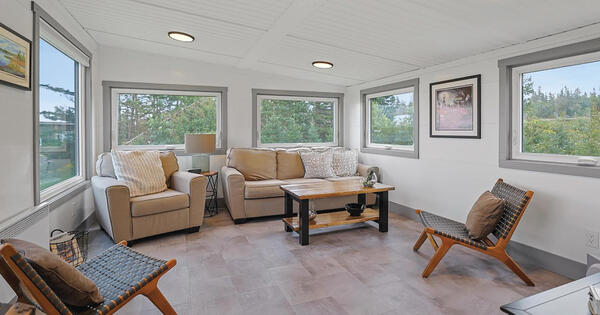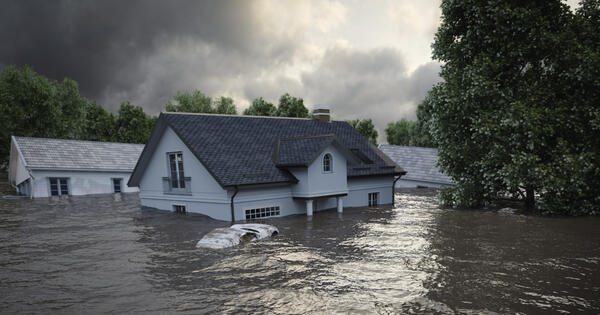This post was originally published in July 2024. Last updated: September 2025.
Flood-resistant home design is the practice of constructing or modifying a home so it can withstand water exposure without significant damage. This approach combines smart material choices, structural strategies, and preventive landscaping to limit the impact of floods. The goal is to keep your home safe, durable, and cost-effective to maintain.
How Can I Tell if My Home Is in a Flood Zone?
Knowing your flood risk is the first step to protecting your home. There are three main ways to assess it:
- Location and Elevation: Homes near rivers, lakes, coasts, or low-lying land are more vulnerable to flooding. Urban areas with poor drainage systems can also be at higher risk. The elevation of your property also plays a significant role — lower elevations are more likely to flood, making it crucial to know the topography of your area.
- Historical Flood Data: Next, examine historical data to understand past flooding events in your area. Investigate previous floods to gauge the likelihood of future occurrences. Local government websites or historical societies often have records of past floods, and the National Weather Service (NWS) and FEMA provide valuable data on historical flood events. Past patterns are a strong indicator of future risk.
- Floodplain Maps: Finally, reviewing floodplain maps is essential. FEMA’s Flood Map Service Center categorizes properties into flood risk zones, helping you determine if your home is in a high-risk area. Local planning and zoning offices can also provide floodplain maps specific to your community. Understanding these maps will help you make informed decisions about flood insurance and necessary home modifications.
To help assess your home or basement’s flood risk, check out these three online resources:
What Types of Floods Should I Prepare For?
Different floods cause different problems, and knowing what you’re most at risk for helps you plan effectively.
| Types of Floods | Characteristics | Impacts | Prevention Tips |
|---|---|---|---|
| Flash Floods | Rapid, intense, and occurs within minutes or hours of rainfall | Dangerous water level rises, sweeping debris | Maintain gutters and drainage systems |
| River Floods | Caused by prolonged rain or snowmelt | Inundates large areas, displaces communities | Elevate homes, build levees or floodwalls |
| Coastal Floods | Driven by tides, storm surges, or tsunamis | Erodes shorelines, causes saltwater damage | Build on stilts, use water-resistant materials |
| Urban Floods | Poor stormwater drainage in cities | Streets and basements flood quickly | Use permeable landscaping, and ensure proper grading |
| Groundwater Floods | Water rises after prolonged rain | Can lead to basement flooding and foundation damage | Install sump pumps and waterproofing systems in basements |


What Building Materials Are Best for Flood-Prone Areas?
Choosing the right materials for your home can make a significant difference in minimizing flood damage. Several materials perform exceptionally well in flood conditions, offering both durability and resilience. Here are some top options and their benefits:
- Concrete: Concrete is highly durable and resistant to water damage. It doesn’t rot, warp, or lose its structural integrity when exposed to water. This makes it an excellent choice for foundations, walls, and flooring in flood-prone areas. Additionally, concrete can be sealed to further enhance its water resistance, providing an added layer of protection.
- Brick: Brick is another strong and durable material that withstands flooding well. It resists water absorption better than many other materials, reducing the risk of mold and mildew growth. And when combined with proper mortar and sealing techniques, brick walls can offer excellent protection against floodwaters. The material also adds aesthetic appeal and long-term value to a home.
- Flood-Resistant Insulation: Traditional insulation materials, such as fiberglass or cellulose, can be easily damaged by water and harbor mold. Flood-resistant insulation, like closed-cell spray foam or rigid foam board, doesn’t absorb water and retains its insulating properties even after being submerged. These types of insulation can help maintain your home’s energy efficiency while reducing the risk of mold and deterioration.
- PVC Panels: PVC panels like Trusscore Wall&CeilingBoard are an excellent alternative to drywall for flood-prone areas. The panels are non-porous, antimicrobial, 100% waterproof, install with a watertight seal, can withstand long-term exposure to flood water filled with bacteria and chemicals, and will never grow mold or mildew. Plus, Trusscore panels can be cleaned and disinfected with soap and water or with high-strength chemical cleaners to return them to their original state. No replacement or patching needed.
Each of these materials brings unique benefits that contribute to a flood-resistant home. By incorporating them into your building or renovation plans, you can significantly enhance your home’s ability to withstand flood conditions and reduce the long-term costs associated with flood damage.



How Do Elevated Home Designs Prevent Flood Damage?
Elevating homes above the base flood elevation (BFE) is a key strategy in flood-resistant home design. This approach involves raising the living spaces of a home above the level at which floodwaters are expected to rise during a base flood event, reducing the risk of water damage and improving overall safety.
Several methods can be used to elevate homes, each with its own advantages and suitability depending on the specific circumstances:
- Stilts/Pilings: Homes are raised on long, sturdy posts driven deep into the ground. This method is commonly used in coastal areas where high tides and storm surges are a concern. Stilts allow water to flow underneath the house, minimizing resistance and reducing the risk of structural damage.
- Piers: Like stilts, piers are shorter and often used in conjunction with a raised foundation. Concrete or masonry piers are built to lift the home above the BFE, providing stability and support. This method is suitable for areas with moderate flood risk.
- Raised Foundations: Involves constructing a higher foundation using concrete blocks or a solid slab. The existing structure can be jacked up and a new, higher foundation built underneath. This method is often used in urban and suburban settings where elevation needs are less extreme but still necessary.
What Are the Benefits of Elevating Homes?
Elevating homes above the BFE offers several significant benefits:
| Reduced Flood Insurance Premiums: Insurance providers recognize the reduced risk associated with elevated homes and often offer lower premiums for properties that have been raised above the BFE. This can result in substantial long-term savings for homeowners. | |
| Lower Risk of Damage: Elevating a home significantly reduces the risk of floodwater entering the living areas, thereby preventing costly water damage, mold growth, and structural issues. This also helps protect personal belongings and essential home systems. | |
| Increased Property Value: Homes designed or retrofitted to be flood-resistant often see an increase in market value. Prospective buyers are more likely to invest in properties that offer enhanced protection against flooding. | |
| Enhanced Safety: Elevating homes not only protects property but also improves the safety of occupants during flood events. With living spaces and critical infrastructure out of harm's way, families can feel more secure during severe weather conditions. |
Incorporating elevation techniques into home design is a practical and effective way to mitigate flood risks, providing long-term benefits for homeowners in flood-prone areas.
How Do I Waterproof My Basement Against Flooding?

Sealing cracks and gaps in your home’s exterior is critical in preventing water intrusion. Even small openings can allow water to seep in during heavy rains or floods, leading to significant damage over time. Water entering through cracks can cause structural damage, mold growth, and deterioration of building materials. Properly waterproofing basements and crawl spaces is vital to prevent water damage in these vulnerable areas. Here are some effective tips:
- Sump Pumps: Install a sump pump in your basement or crawl space to actively remove water that accumulates. Sump pumps automatically activate when water levels rise, pumping water out and away from your home. Ensure you have a battery backup system to keep the pump running during power outages.
- Backflow Valves: Use backflow valves on your home’s sewer lines to prevent sewage from backing up into your basement during heavy rains or flooding. These valves allow water to flow out but prevent it from coming back in, protecting your home from contaminated floodwater.
- Waterproofing Membranes: Apply waterproofing membranes to the exterior walls of your basement or crawl space. These membranes create a durable barrier that prevents water from penetrating the walls. Interior waterproofing paints and sealants can also be used to add an extra layer of protection.
FAQs About Flood-Resistant Homes
Is drywall safe to use in flood-prone areas?
No — drywall is highly porous and quickly absorbs water, which leads to swelling, crumbling, and mold growth within days of a flood. Even minor exposure usually requires replacement. In flood-prone homes, drywall should be avoided in basements, lower levels, or anywhere there’s a risk of water intrusion. A better alternative is PVC wall panels, which won’t absorb moisture, resist mold and mildew, and can be cleaned and reused even after significant water exposure.
How much does it cost to build a flood-resistant home?
The cost depends on your location, design choices, and level of flood protection needed. Adding elevation (stilts, piers, or raised foundations) is often the most expensive step but can reduce long-term insurance costs. Upgrading to flood-resistant materials like concrete and PVC panels also comes with a higher upfront cost but saves thousands in repairs after a flood. Think of it as an investment — proactive flood-resistant design usually pays for itself the first time you avoid major damage.
Do flood barriers really work?
Yes, when used properly, flood barriers can provide an important line of defense. Permanent solutions like flood walls and levees offer long-term protection for high-risk areas, while temporary options like removable shields or sandbags are effective for short-term storms or unexpected flooding. Barriers shouldn’t be your only strategy, but when combined with proper elevation and drainage systems, they can significantly reduce water intrusion.
Can Trusscore Wall&CeilingBoard withstand flooding?
Non-porous and antimicrobial Trusscore panels are 100% waterproof, install with a watertight seal, can withstand long-term exposure to flood water filled with bacteria and chemicals, and will never grow mold or mildew. After being exposed to contaminants in flood water, Trusscore panels can be cleaned and disinfected with soap and water or with high-strength chemical cleaners to return them to their original state.
Can I install Trusscore Wall&CeilingBoard as wainscoting?
Yes, you can install Trusscore Wall&CeilingBoard on the bottom portion of a wall like wainscoting. This is a particularly great idea if you're replacing water damaged drywall or are protecting a flood-prone area of your home. For more information and installation instructions, read our PVC Wainscoting blog post.
Does Trusscore Wall&CeilingBoard meet FEMA guidelines for building materials in flood areas?
FEMA’s National Flood Insurance Program (NFIP) recommends water-resistant, non-porous materials to reduce flood damage and speed up recovery. With its water resistance, mold prevention, and easy-to-clean properties, Trusscore Wall&CeilingBoard fully aligns with FEMA’s standards for flood resilience in flood-prone and hurricane-prone areas.
Will flood insurance cover everything?
Not always. Standard homeowners’ insurance policies typically don’t cover flood damage, which is why separate coverage through the National Flood Insurance Program (NFIP) or private insurers is essential. Even then, policies often have limits on what they’ll reimburse — for example, finished basements, personal belongings, and landscaping may not be fully covered. It’s important to read your policy carefully and understand what’s protected so you’re not caught off guard after a flood.
Flood-resistant home design is more important than ever. By understanding flood risks and implementing strategies such as using flood-resistant materials, elevating structures, proper landscaping, sealing, and installing effective drainage systems, you can protect your home from the devastating impacts of flooding. Take proactive steps today — explore additional resources and consider consulting professionals for personalized advice to ensure your home remains safe and secure.






